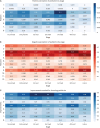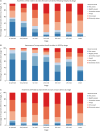Barriers to Choosing Pediatrics as a Specialty: Insights From a Cross-Sectional Analysis
- PMID: 39079682
- PMCID: PMC11286327
- DOI: 10.3346/jkms.2024.39.e211
Barriers to Choosing Pediatrics as a Specialty: Insights From a Cross-Sectional Analysis
Abstract
Background: The pediatric field in South Korea is experiencing a significant workforce crisis due to a sharp decline in pediatricians, exacerbated by a decrease in pediatric residents and a series of distressing incidents in pediatric healthcare institutions. No prior studies have explored the waning interest in pediatrics among South Korea's medical students and interns, which our research seeks to address during a pediatric workforce decline. This study aimed to investigate the declining interest in pediatrics among medical students and interns in South Korea amidst decreasing birth rates. We conducted a comprehensive survey to identify the factors deterring young medical professionals from pursuing a career in pediatrics.
Methods: In this cross-sectional study, in December 2023 we surveyed medical students and interns at Jeonbuk National University and Hospital using a 40-item electronically distributed questionnaire tailored to assess the factors influencing specialty choice, focusing on pediatrics. The participants were divided into the pre-clinical and clinical groups, allowing for analysis across educational stages. The survey covered demographics, perceptions of pediatrics, attitudes toward medical errors, and awareness of critical issues; it included a range of question types to ensure detailed and nuanced data collection.
Results: Our findings revealed a clear decrease in interest in pediatrics as medical students progressed through their education, with 86.69% displaying negative views. Although a sense of mission and emotional satisfaction from patient interactions were highlighted as positive influences, they were significantly countered by worries related to declining pediatric populations, legal challenges, and interactions with patient guardians. Additionally, 95.84% of the participants recognized the critical role of vital pediatric departments; however, litigation risks and psychological burdens substantially affected their willingness to specialize in these areas. The analysis also showed an increasing awareness of pediatric incidents as students advanced through their education; however, this did not directly correlate with their choice of specialty (P = 0.090).
Conclusion: The results emphasize the necessity for targeted interventions to alleviate concerns and improve the attractiveness of pediatrics. These efforts are essential to counteract the declining interest and ensure a sustainable pediatric workforce for the future.
Keywords: Interns; Medical Students; Pediatrics; Specialty Choice.
© 2024 The Korean Academy of Medical Sciences.
Conflict of interest statement
Dr. Jihye You was supported by funds from the Biomedical Research Institute, Jeonbuk National University Hospital. The content is solely the responsibility of the authors and does not necessarily represent the official views of the Agency for Healthcare Research and Quality. The other author declares no potential conflicts of interest.
Figures





References
-
- The Korean Pediatric Society. [Updated 2022]. [Accessed January 19, 2024]. https://www.pediatrics.or.kr/bbs/index.html?code=notice&category=&gubun=...
-
- The Korean Society of Neonatology. [Updated 2018]. [Accessed January 19, 2024]. https://www.neonatology.or.kr/
-
- The Supreme Court of Korea. Decision on Citrobacter Freundii Infection Leading to Fatal Septicemia. [Updated 2022]. [Accessed April 23, 2024]. https://judges.scourt.go.kr/portal/news/NewsViewAction.work?seqnum=4784&... .
-
- Kim J. In an era of low birth rates, support measures for children and adolescents in crisis. Med Policy Forum. 2023;20(4):48–53.
-
- Ministry of Health and Welfare. [Updated 2023]. [Accessed January 20, 2024]. https://www.mohw.go.kr/board.es?mid=a10504000000&bid=0030&cg_code=

